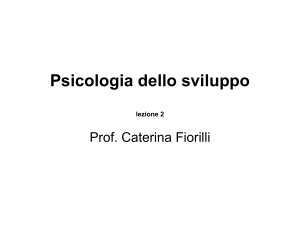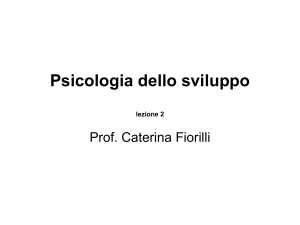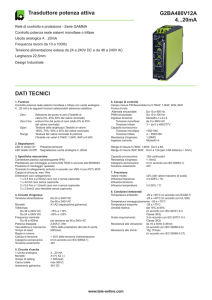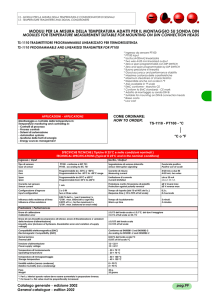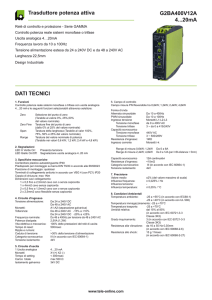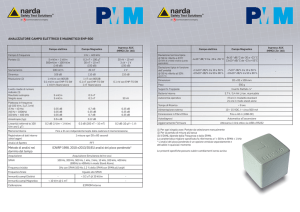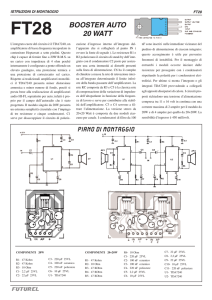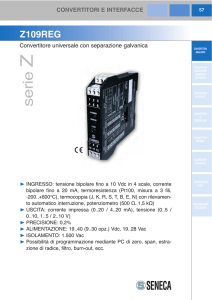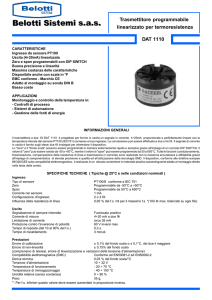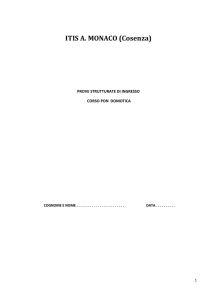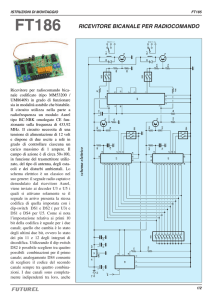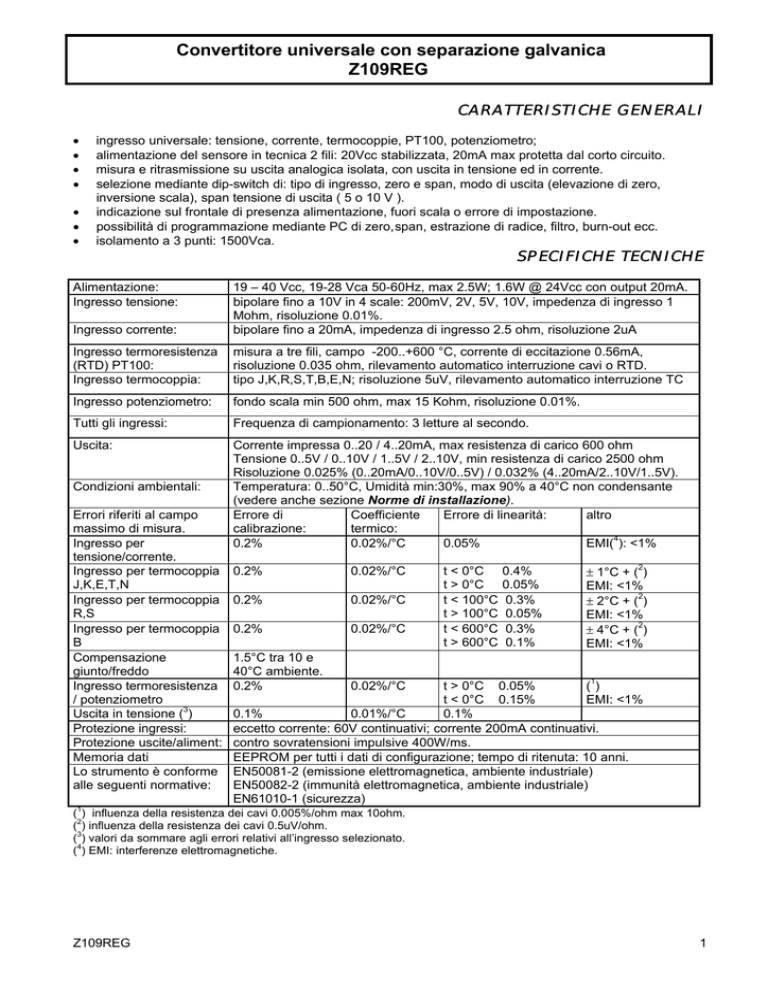
Convertitore universale con separazione galvanica
Z109REG
CARATTERISTICHE GENERALI
•
•
•
•
•
•
•
ingresso universale: tensione, corrente, termocoppie, PT100, potenziometro;
alimentazione del sensore in tecnica 2 fili: 20Vcc stabilizzata, 20mA max protetta dal corto circuito.
misura e ritrasmissione su uscita analogica isolata, con uscita in tensione ed in corrente.
selezione mediante dip-switch di: tipo di ingresso, zero e span, modo di uscita (elevazione di zero,
inversione scala), span tensione di uscita ( 5 o 10 V ).
indicazione sul frontale di presenza alimentazione, fuori scala o errore di impostazione.
possibilità di programmazione mediante PC di zero, span, estrazione di radice, filtro, burn-out ecc.
isolamento a 3 punti: 1500Vca.
Alimentazione:
Ingresso tensione:
SPECIFICHE TECNICHE
Ingresso corrente:
19 – 40 Vcc, 19-28 Vca 50-60Hz, max 2.5W; 1.6W @ 24Vcc con output 20mA.
bipolare fino a 10V in 4 scale: 200mV, 2V, 5V, 10V, impedenza di ingresso 1
Mohm, risoluzione 0.01%.
bipolare fino a 20mA, impedenza di ingresso 2.5 ohm, risoluzione 2uA
Ingresso termoresistenza
(RTD) PT100:
Ingresso termocoppia:
misura a tre fili, campo -200..+600 °C, corrente di eccitazione 0.56mA,
risoluzione 0.035 ohm, rilevamento automatico interruzione cavi o RTD.
tipo J,K,R,S,T,B,E,N; risoluzione 5uV, rilevamento automatico interruzione TC
Ingresso potenziometro:
fondo scala min 500 ohm, max 15 Kohm, risoluzione 0.01%.
Tutti gli ingressi:
Frequenza di campionamento: 3 letture al secondo.
Uscita:
Corrente impressa 0..20 / 4..20mA, max resistenza di carico 600 ohm
Tensione 0..5V / 0..10V / 1..5V / 2..10V, min resistenza di carico 2500 ohm
Risoluzione 0.025% (0..20mA/0..10V/0..5V) / 0.032% (4..20mA/2..10V/1..5V).
Temperatura: 0..50°C, Umidità min:30%, max 90% a 40°C non condensante
(vedere anche sezione Norme di installazione).
Errore di
Coefficiente
Errore di linearità:
altro
calibrazione:
termico:
0.2%
0.02%/°C
0.05%
EMI(4): <1%
Condizioni ambientali:
Errori riferiti al campo
massimo di misura.
Ingresso per
tensione/corrente.
Ingresso per termocoppia
J,K,E,T,N
Ingresso per termocoppia
R,S
Ingresso per termocoppia
B
Compensazione
giunto/freddo
Ingresso termoresistenza
/ potenziometro
Uscita in tensione (3)
Protezione ingressi:
Protezione uscite/aliment:
Memoria dati
Lo strumento è conforme
alle seguenti normative:
0.2%
0.02%/°C
0.2%
0.02%/°C
0.2%
0.02%/°C
1.5°C tra 10 e
40°C ambiente.
0.2%
0.02%/°C
t < 0°C
t > 0°C
t < 100°C
t > 100°C
t < 600°C
t > 600°C
0.4%
0.05%
0.3%
0.05%
0.3%
0.1%
± 1°C + (2)
EMI: <1%
2
± 2°C + ( )
EMI: <1%
2
± 4°C + ( )
EMI: <1%
t > 0°C 0.05%
(1)
t < 0°C 0.15%
EMI: <1%
0.1%
0.01%/°C
0.1%
eccetto corrente: 60V continuativi; corrente 200mA continuativi.
contro sovratensioni impulsive 400W/ms.
EEPROM per tutti i dati di configurazione; tempo di ritenuta: 10 anni.
EN50081-2 (emissione elettromagnetica, ambiente industriale)
EN50082-2 (immunità elettromagnetica, ambiente industriale)
EN61010-1 (sicurezza)
1
( ) influenza della resistenza dei cavi 0.005%/ohm max 10ohm.
(2) influenza della resistenza dei cavi 0.5uV/ohm.
3
( ) valori da sommare agli errori relativi all’ingresso selezionato.
(4) EMI: interferenze elettromagnetiche.
Z109REG
1
NORME DI INSTALLAZIONE
Il modulo Z109REG è progettato per essere montato su guida DIN 46277, in posizione verticale.
Per un funzionamento ed una durata ottimale, bisogna assicurare una adeguata ventilazione al/ai moduli,
evitando di posizionare canaline o altri oggetti che occludano le feritoie di ventilazione.
Evitare il montaggio dei moduli sopra ad apparecchiature che generano calore; è consigliabile il montaggio
nella parte bassa del quadro.
CONDIZIONI GRAVOSE DI FUNZIONAMENTO:
Le condizioni di funzionamento gravose sono le seguenti:
• Tensione di alimentazione elevata (> 30Vcc / > 26 Vca)
• Alimentazione del sensore in ingresso.
• Utilizzo dell’uscita in corrente impressa.
Quando i moduli sono montati affiancati è possibile che sia necessario separarli di almeno 5 mm nei
seguenti casi:
•
•
Con temperatura del quadro superiore a 45°C e almeno una delle condizioni di funzionamento gravoso
verificata.
Con temperatura del quadro superiore a 35°C e almeno due delle condizioni di funzionamento gravoso
verificate.
COLLEGAMENTI ELETTRICI
Si raccomanda l’uso di cavi schermati per il collegamento dei segnali; lo schermo dovrà essere collegato ad
una terra preferenziale per la strumentazione. Inoltre è buona norma evitare di far passare i conduttori nelle
vicinanze di cavi di installazioni di potenza quali inverter, motori, forni ad induzione ecc.
ALIMENTAZIONE
La tensione di alimentazione deve essere compresa tra 19 e 40 Vcc (polarità
indifferente), 19 e 28 Vca; vedere anche la sezione NORME DI NSTALLAZIONE.
I Iimiti superiori non devono essere superati, pena gravi danni al modulo.
E’ necessario proteggere la sorgente di alimentazione da eventuali guasti del modulo
mediante fusibile opportunamente dimensionato.
INGRESSO IN CORRENTE
TERMOCOPPIA
L’alimentazione del
loop è data dal sensore
INGRESSO IN TENSIONE
L’alimentazione del
loop è data dal modulo
INGRESSO TERMORESISTENZA /
POTENZIOMETRO
USCITA RITRASMESSA
Tensione
Z109REG
INGRESSO
Corrente
Impressa
Corrente
alim. esterna
2
SELEZIONE INGRESSO / SPAN DI MISURA
La selezione del tipo di ingresso si effettua mediante impostazione del
gruppo dip-switch SW1 posto a lato del modulo.
Ad ogni tipo di ingresso corrisponde un certo numero di valori di inizio scala
e di fondo scala selezionabili mediante il gruppo SW2.
Nella tabella sottostante vengono elencati i possibili valori di zero e span in
funzione del tipo di ingresso selezionato.
Nella tabella, la colonna di sinistra indica la combinazione di dip-sw da
impostare per lo zero e per lo span prescelto.
N.B.: l’impostazione dei dip-switch deve avvenire a modulo non
alimentato, pena il possibile danneggiamento del modulo stesso.
Ingresso in tensione
SPAN
(*)
100mV
200mV
500mV
1V
2V
5V
10V
Ingresso resistenza /
potenziometro
ZERO
SPAN
(*)
(*)
0 ohm
1 kohm
1 kohm
2 kohm
2 kohm
3 kohm
3 kohm
5 kohm
5 kohm
7 kohm
7 kohm
10 kohm
10 kohm
15 kohm
1
2
3
4
5
6
7
8
Termocoppia J
ZERO
SPAN
(*)
(*)
-200 °C
100 °C
-100 °C
200 °C
0 °C
300 °C
100 °C
400 °C
200 °C
500 °C
300 °C
800 °C
500 °C
1000 °C
Termocoppia K
ZERO
SPAN
(*)
(*)
-200 °C
200 °C
-100 °C
400 °C
0 °C
600 °C
100 °C
800 °C
200 °C
1000 °C
300 °C
1200 °C
500 °C
1300 °C
Termocoppia R
ZERO
SPAN
(*)
(*)
0 °C
400 °C
100 °C
600 °C
200 °C
800 °C
300 °C
1000 °C
400 °C
1200 °C
500 °C
1400 °C
800 °C
1750 °C
Termocoppia S
ZERO
SPAN
(*)
(*)
0 °C
400 °C
100 °C
600 °C
200 °C
800 °C
300 °C
1000 °C
400 °C
1200 °C
600 °C
1400 °C
800 °C
1750 °C
1
2
3
4
5
6
7
8
Termocoppia T
ZERO
(*)
-200 °C
-100 °C
-50 °C
0 °C
50 °C
100 °C
150 °C
Termocoppia B
ZERO
SPAN
(*)
(*)
0 °C
500 °C
500 °C
600 °C
600 °C
800 °C
700 °C
1000 °C
800 °C
1200 °C
1000 °C
1500 °C
1200 °C
1800 °C
Termocoppia E
ZERO
SPAN
(*)
(*)
-200 °C
50 °C
-100 °C
100 °C
0 °C
200 °C
100 °C
300 °C
150 °C
400 °C
200 °C
600 °C
400 °C
800 °C
Termocoppia N
ZERO
SPAN
(*)
(*)
-200 °C
200 °C
-100 °C
400 °C
0 °C
600 °C
100 °C
800 °C
200 °C
1000 °C
300 °C
1200 °C
500 °C
1300 °C
ZERO
(*)
0V
400mV
1V
2V
-2V
-5V
-10V
1
2
3
4
5
6
7
8
Z109REG
SPAN
(*)
50 °C
100 °C
150 °C
200 °C
250 °C
300 °C
400 °C
Ingresso in corrente
ZERO
(*)
0 mA
1 mA
4 mA
-1 mA
-5 mA
-10 mA
-20 mA
SPAN
(*)
1 mA
2 mA
3 mA
4 mA
5 mA
10 mA
20 mA
Ingresso PT100
(RTD)
ZERO
SPAN
(*)
(*)
-200 °C
50 °C
-100 °C
100 °C
-50 °C
200 °C
0 °C
300 °C
50 °C
400 °C
100 °C
500 °C
200 °C
600 °C
3
IMPOSTAZIONE ZERO E SPAN DI MISURA A PIACERE
I pulsanti ZERO e SPAN posti sotto al gruppo dip-switch SW2, permettono di impostare uno zero e un span a
piacere all’interno di quello preimpostato per il tipo di ingresso selezionato.
Per ottenere questo bisogna eseguire le seguenti operazioni:
1. Impostare il tipo di ingresso, zero e span di misura su SW2 che comprendano zero e span di misura
desiderato.
2. Dare alimentazione al modulo.
3. Predisporre un calibratore o un simulatore del segnale che si intende misurare e ritrasmettere.
4. Impostare sul calibratore (o altro) il valore di zero desiderato.
5. Premere il pulsante ZERO per almeno 3 sec. Un lampo del led giallo sul frontale indica l’avvenuta
memorizzazione del valore.
6. Ripetere i punti 4 e 5 per il valore di SPAN desiderato.
7. Togliere alimentazione al modulo e impostare ZERO n°1 e SPAN n°1 sul gruppo SW2 (posizione (*) sulla
tabella).
Ora il modulo è configurato per lo span e lo zero richiesti; per riprogrammarlo anche per un tipo diverso di
ingresso è sufficiente ripetere l’intera operazione.
SELEZIONE USCITA
I dip-switch numero 7 ed 8 del gruppo SW2 permettono di
impostare rispettivamente l’uscita con o senza elevazione di
zero, uscita normale o invertita.
Il gruppo dip-switch SW3 permette di selezionare la tensione
d’uscita.
N.B.: l’impostazione dei dip-switch deve avvenire a modulo
non alimentato, pena il possibile danneggiamento del
modulo stesso.
IMPOSTAZIONE MEDIANTE PC
Per mezzo di un PC e del software ZSETUP è possibile impostare oltre a zero e span, altri parametri
normalmente fissi:
• Filtro digitale (normalmente escluso);
• Estrazione di radice (normalmente escluso);
• Burn-out negativo ( normalmente positivo);
Le istruzioni per l’impostazione ed il cavetto di collegamento sono forniti a corredo del software che deve
essere richiesto come accessorio.
E.S.A.M. unicenter s.r.l.
Elettronica Strumenti Apparecchiature Misura
Z109REG
20010 Bareggio (MI) Italia – Via S. Pietro, 10
Tel. 02.903.61.297 (3 l.r.a.) – fax 02.903.62.314
4
Universal converter with galvanic separation
Z109REG
GENERAL CHARACTERISTICS
•
•
•
•
•
•
•
universal input: voltage, current, thermocouples, PT100, potentiometer;
sensor powered by 2-wire technique: 20Vcc stabilised, 20mA max with short-circuit protection.
measurement and re-transmission on isolated analog output, with voltage and current output.
dip-switch for selecting: type of input, zero and span, output mode (zero elevation, scale inversion),
output voltage span ( 5 or 10 V )
front panel indicating: power on, off scale or setting error.
facility for programming the following with a PC: zero, span, square root extraction, filter, burn-out etc.
3-point insulation: 1500Vac.
Power supply:
Voltage input:
TECHNICAL SPECIFICATIONS
Current input:
19 – 40 Vdc, 19-28 Vac 50-60Hz, max 2.5W; 1.6W @ 24Vcc with 20mA output.
bipolar up to 10V in 4 scales: 200mV, 2V, 5V, 10V, input impedance 1 Mohm,
resolution 0.01%.
bipolar up to 20mA, input impedance 2.5 ohm, resolution 2uA
Thermal-resistor input
(RTD) PT100:
Thermocouple input:
3-wire measurement, range -200..+600 °C, energising current 0.56mA,
resolution 0.035 ohm, automatic detection of cable interruption or RTD.
type J,K,R,S,T,B,E,N; resolution 5uV, automatic detection of TC interruption.
Potentiometer input:
full scale min 500 ohm, max 15 Kohm, resolution 0.01%.
All inputs:
Sampling frequency : 3 samples/second.
Output:
Generated current 0..20 / 4..20mA, max load resistance 600 ohm
Voltage 0..5V / 0..10V / 1..5V / 2..10V, min load resistance 2500 ohm
Resolution 0.025% (0..20mA/0..10V/0..5V) / 0.032% (4..20mA/2..10V/1..5V).
Environmental conditions: Temperature: 0..50°C, Humidity min: 30%, max: 90% a 40°C non condensing
(also see section Installation instructions).
Errors referred to max
Calibration error:
Thermal
Linearity error:
others:
measuring range
Coefficient:
Input for voltage/current
0.2%
0.02%/°C
0.05%
EMI(4): <1%
Input for thermocouple
0.2%
0.02%/°C
t < 0°C 0.4%
± 1°C + (2)
J,K,E,T,N
t > 0°C 0.05%
EMI: <1%
Input for thermocouple
0.2%
0.02%/°C
t < 100°C 0.3%
± 2°C + (2)
R,S
t > 100°C 0.05%
EMI: <1%
Input for thermocouple B 0.2%
0.02%/°C
t < 600°C 0.3%
± 4°C + (2)
t > 600°C 0.1%
EMI: <1%
Cold junction
1.5°C in ambient
compensation
range 10 to 40°C .
Input for thermal
0.2%
0.02%/°C
t > 0°C 0.05%
(1)
resistor/potentiometer
t < 0°C 0.15%
EMI: <1%
3
Voltage output ( )
0.1%
0.01%/°C
0.1%
Protection for inputs :
except current: 60V continuous; current 200mA continuous.
Protection for
against impulsive over-voltages 400W/ms.
outputs/power supply:
Data memory
EEPROM for all configuration data; storage time: 10 years.
The instrument conforms EN50081-2 (electromagnetic emission, industrial ambient)
to the following standards: EN50082-2 (electromagnetic immunity, industrial ambient)
EN61010-1 (safety)
(1) influence of cable resistance 0.005%/ohm max 10ohm.
(2) influence of cable resistance 0.5uV/ohm.
(3) values to be added to the errors of the selected input.
(4) EMI: electromagnetic interferences.
Z109REG
5
INSTALLATION INSTRUCTIONS
Module Z109REG was designed for fitting to guide DIN 46277, in a vertical position.
For optimum operation and long life, make sure adequate ventilation is provided for the module/s, avoiding
placing raceways or other objects which could obstruct the ventilation grilles.
Do not install the modules above appliances generating heat – we advise you to install in the lower part of the
panel.
SEVERE OPERATING CONDITIONS:
Severe operating conditions are as follows:
• High power supply voltage (> 30Vcc / > 26 Vac)
• Power supply of the sensor at input.
• Use of the output on generated current
When modules are installed side by side, it may be necessary to separate them by at least 5 mm in the
following cases:
•
•
If panel temperature exceed 45°C and at least one of the severe operating conditions exists.
If panel temperature exceed 35°C and at least two of the severe operating conditions exist.
ELECTRICAL CONNECTIONS
We advise you to use shielded cables for connecting signals. The shield must be connected to an earth wire
used specifically for instrumentation. Moreover, it is good practice to avoid routing conductors near power
appliances such as inverters, motors, induction ovens, etc.
POWER SUPPLY
Power supply voltage must be in the range 19 to 40 Vdc (at any polarity), 19 to 28 Vac;
also see section; INSTALLATION INSTRUCTIONS.
The upper limits must not be exceeded, to avoid serious damage to the module.
Protect the power supply source against possible damage of the module by using a fuse
of suitable size.
CURRENT INPUT
The loop is powered by
the sensor
VOLTAGE INPUT
THERMOCOUPLE INPUT
The loop is powered by
the module
RTD / POTENTIOMETER
INPUT
RE-TRANSMITTED OUTPUT
Voltage
Z109REG
Generated
current
Extern. power
supply current.
6
SELECTION: INPUT / MEASURING SPAN
The type of input is selected by setting the SW1 dip-switch group at the
side of the module.
Every type of input is matched to a certain number of scale
commencement and full-scale values which can be selected with the SW2
group.
The table below lists possible zero and span values according to the type of
input selected.
The left hand column in the table indicates the dip-switch combination to be
set for zero and for the selected span.
N.B.: dip-switches must be set while the module is powered down,
otherwise, the module may be damaged.
Voltage input
Resistor/Potentiometer input
ZERO
(*)
0 mA
1 mA
4 mA
-1 mA
-5 mA
-10 mA
-20 mA
SPAN
(*)
1 mA
2 mA
3 mA
4 mA
5 mA
10 mA
20 mA
Input PT100
(RTD)
ZERO
SPAN
(*)
(*)
-200 °C
50 °C
-100 °C
100 °C
-50 °C
200 °C
0 °C
300 °C
50 °C
400 °C
100 °C
500 °C
200 °C
600 °C
1
2
3
4
5
6
7
8
ZERO
(*)
0V
400mV
1V
2V
-2V
-5V
-10V
SPAN
(*)
100mV
200mV
500mV
1V
2V
5V
10V
ZERO
(*)
0 ohm
1 kohm
2 kohm
3 kohm
5 kohm
7 kohm
10 kohm
1
2
3
4
5
6
7
8
Thermocouple J
ZERO
(*)
-200 °C
-100 °C
0 °C
100 °C
200 °C
300 °C
500 °C
SPAN
(*)
100 °C
200 °C
300 °C
400 °C
500 °C
800 °C
1000 °C
Thermocouple K
ZERO
SPAN
(*)
(*)
-200 °C
200 °C
-100 °C
400 °C
0 °C
600 °C
100 °C
800 °C
200 °C
1000 °C
300 °C
1200 °C
500 °C
1300 °C
Thermocouple R
ZERO
SPAN
(*)
(*)
0 °C
400 °C
100 °C
600 °C
200 °C
800 °C
300 °C
1000 °C
400 °C
1200 °C
500 °C
1400 °C
800 °C
1750 °C
Thermocouple S
ZERO
SPAN
(*)
(*)
0 °C
400 °C
100 °C
600 °C
200 °C
800 °C
300 °C
1000 °C
400 °C
1200 °C
600 °C
1400 °C
800 °C
1750 °C
1
2
3
4
5
6
7
8
Thermocouple T
ZERO
(*)
-200 °C
-100 °C
-50 °C
0 °C
50 °C
100 °C
150 °C
SPAN
(*)
50 °C
100 °C
150 °C
200 °C
250 °C
300 °C
400 °C
Thermocouple B
ZERO
SPAN
(*)
(*)
0 °C
500 °C
500 °C
600 °C
600 °C
800 °C
700 °C
1000 °C
800 °C
1200 °C
1000 °C
1500 °C
1200 °C
1800 °C
Thermocouple E
ZERO
SPAN
(*)
(*)
-200 °C
50 °C
-100 °C
100 °C
0 °C
200 °C
100 °C
300 °C
150 °C
400 °C
200 °C
600 °C
400 °C
800 °C
Thermocouple N
ZERO
SPAN
(*)
(*)
-200 °C
200 °C
-100 °C
400 °C
0 °C
600 °C
100 °C
800 °C
200 °C
1000 °C
300 °C
1200 °C
500 °C
1300 °C
Z109REG
SPAN
(*)
1 kohm
2 kohm
3 kohm
5 kohm
7 kohm
10 kohm
15 kohm
Current input
7
SETTING ZERO AND SPAN AT WILL
The ZERO and SPAN push-button under the SW2 dip-switch group enables you to set zero or span at will
within the pre-set zero/span values for the type of input selected.
To obtain this facility, the following operations must be carried out:
1. Set the type of input, zero and measurement span on SW2s which include the required zero and
measuring span.
2. Power up the module
3. Supply a calibrator or simulator of the signal you wish to measure or re-transmit.
4. Set the required zero value on the calibrator (or other instrument)
5. Press the ZERO push-button for at least 3 sec. The yellow LED on the front panel flashes to indicate the
value has been stored.
6. Repeat points 4 and 5 for the required SPAN value.
7. Cut power to the module and set ZERO n°1 and SPAN n°1 on group SW2 (position (*) in table).
The module is now configured for the required span and zero. To re-program it (e.g. for a different type of
input) repeat the whole procedure.
SELECTING THE OUTPUT
Dip-switches numbers 7 and 8 of the SW2 group enable you to
set the output with or without zero elevation, or as a normal or
reversed output.
The SW3 dip-switch group enables you to select the output
voltage.
N.B.: dip-switches must be set while the module is powered
down, otherwise, the module may be damaged.
SETTING WITH A PC
By using a PC and ZSETUP software, you can set other normally fixed parameters in addition to zero and
span:
• Digital filter (normally disabled);
• Square root extraction (normally disabled);
• Negative burn-out (normally positive);
Instructions for setting and for the connection cable are supplied with the software (to be requested as an
accessory item)
E.S.A.M. unicenter s.r.l.
Elettronica Strumenti Apparecchiature Misura
Z109REG
20010 Bareggio (MI) Italia – Via S. Pietro, 10
Tel. 02.903.61.297 (3 l.r.a.) – fax 02.903.62.314
8

